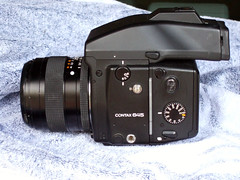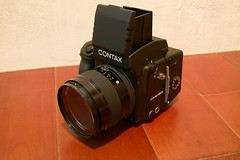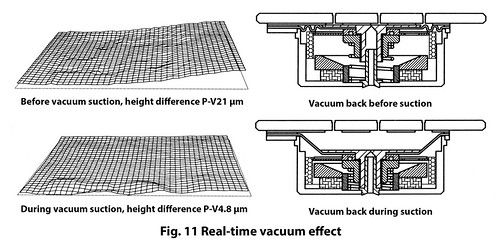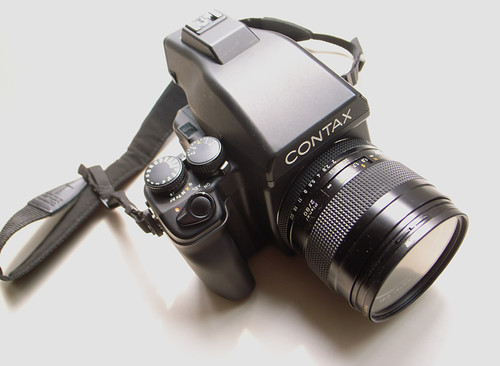Contax 645 AF
The Contax 645 AF is a 6×4.5cm medium format, autofocus film camera, introduced by Kyocera under the Contax brand on 20 February 1999 in Japan. Competing cameras include the Pentax 645N and Mamiya 645 AF. The camera system was discontinued in 2005.
Contents
Development
In a report, the Kyocera Optical Devices Division stated existing Contax cameras and Carl Zeiss lenses were highly appreciated, but users requested a medium format camera for even higher quality. For this reason Kyocera developed a 645 AF system, with the following main features: 1) newly developed lenses from Carl Zeiss 2) emphasis on operability of manual focus besides autofocus 3) high precision film flatness 4) high speed shutter which allows use of large aperture in daylight 5) system configuration which allows for future development 6) operation and automation based on 35mm Contax cameras.[1]
Features
The camera system has a range of interchangeable lenses and finders. The body materials are similar to their Contax RTS 35mm SLR cameras.
The metering TTL system can be used in either spot or center-weighted modes. Exposure modes include AV (aperture priority), TV (shutter priority) and manual exposure. Exposure compensation is available from -3 to 3 stops, in 1/3 steps. Flash exposure modes include TTL auto flash, TTL auto pre-flash and manual pre-flash modes.
The vertical-travelling electronic focal plane shutter design has a maximum speed of 1/4000 of a second. In AV mode: 30 sec to 1/4000, in TV mode, 8 sec to 1/4000. There is a bulb mode and flash sync is also available at 1/125 of a second. There is an electronic self timer with either 2 or 10 second delay.
The Carl Zeiss lenses have a built-in motor which allows auto and manual focus override without having to change lens modes.
The camera uses interchangeable film backs with dark slides, with inserts available for both 120 and 220 film. The back has a film-reminder memo holder. The film loading is automatic with bar coded film and will automatically advance to the first frame. Non coded film requires aligning the backing paper start indicator. Bar coded film ISO can be read automatically with a range of 25 to 5000 ISO. It can also be manually set from 6 to 6400 ISO. The film transport system is motorized, with automatic advance of up to 1.6 fps. It is powered by a 2CR5 battery.
Gallery

|
| left side image by LNEB (Image rights) |

|
| with WLF image by Yuchen Chang (Image rights) |

|
| Vacuum back effect. Reproduced from an article in the Japanese periodical Shashin Kōgyō (Photographic Industries), 5/1999 p. 63.[1] Image presumably originally by Kyocera. scanned by Camera Historian (Image rights) |
System
|
Lens
Film
|
Body
Finder
Focus screen
|
|
Notes
- ↑ 1.0 1.1 Shashin Kōgyō (Photographic Industries) 5/1999 pp. 58-71
Links
In English:
- Contax 645 AF Medium Format SLR Camera at medfmt via Internet Archive: The Wayback Machine
- Contax 645 Review / Contax 645 Lens System by Chris Lee at Photo.net via Internet Archive: The Wayback Machine
- Contax 645 AF Review at Photograpy Review
- Why Carl Zeiss lenses for Contax are made in Japan, Zeiss Contax Relationship (archived) at Dante Stella
- Contax 645 instruction manual at Orphancameras.com
In Spanish:

